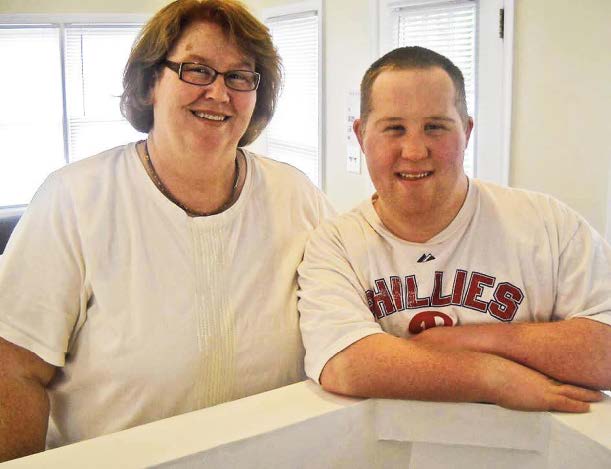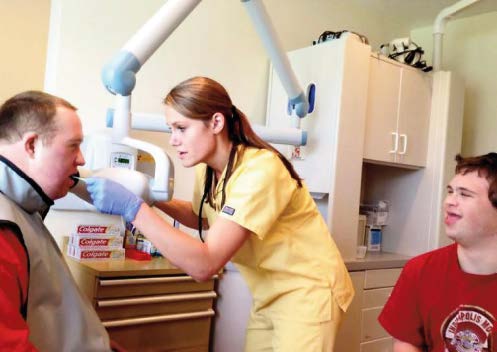THE NEED
You wake up one morning and your tooth hurts. Although it's not your favorite thing you call your dentist, make an appointment and go get it fixed. You're nervous but you tell the dentist that, she helps you through it, and you're ok. Then you realize you need to get a blood test done for your insurance physical so you stop by the lab. Again, you're nervous because needles aren't your favorite things, so you tell the phlebotomist, he gives you a moment to collect yourself, and you get through it. You also need a haircut so you stop to get that haircut without a moment's thought. Now let's talk about the experience two other people had in their typical day.
Mandy, at age 9, is a little girl who loves to sing but also happens to have Down syndrome. Her dental appointment started by being so afraid that she peed herself in the parking lot. After the dental appointment, she went to get a haircut and three people held her down, including her mom, who thought that's how it had to be. John, who loves music and was in a rock band in his younger days fell off a ladder and sustained traumatic brain injury at age 39. Now at 43 John doesn't speak and needs help with everyday life. When he went to his dentist appointment, he hit and bit the dental staff because of his fear. At his blood draw appointment, he ran out of the room at the sight of the needle, then had five adults hold him down to get that blood. These individuals represent people with developmental disabilities1 (i.e. Down syndrome, autism, cerebral palsy) and adult onset disability (i.e. traumatic brain injury or dementia). Although total disability population percentages vary depending on source, nationally, the estimate of significant disability is 11% to 19%.2
Simply put, over 1 in 10 people in a supermarket queue will have a disability. It's estimated that over 3% of the world population has an intellectual disability.3 Of those 10 or so people standing in line at the supermarket, chances are that one of them either has an intellectual disability, or that their lives are touched by someone who has an intellectual disability. People with disabilities, especially those with intellectual disabilities, are very often not seen at a "regular" doctor or dentist or salon. According to Dr. Steven Altabet, researcher at University of Washington, 43% of people with disabilities refuse to participate in dental exams. Of the remaining 57%, 24% reported anxiety and worry.4 Dr. Altabet also reports that only 20% of dental providers are willing to provide care to people with disabilities because of resistance.5 Special Olympics research into the competency of cli nicians treating people with intellectual disabilities showed that 52% of medical school Practice Without Pressure prepares fearful clients for medical, dental and personal care. The PWP Practice Model™ provides a framework for people to become comfortable with procedures they once feared, resisted or avoided. This step-by-step approach promotes trust and learning. Learn more at pwpde.org deans, 53% of dental school deans, 56% of students and 32% of medical residency program directors responded that graduates were "not competent" to treat people with intellectual disabilities.6
Until recently, best practice for people who can't be talked through a procedure has been sedation and restraint.7 For example, according to the American Academy of Pediatric Dentistry (adults with disabilities are lumped in with pediatrics in dental guidelines), it is ok to use protective stabilization – the restriction of patient's freedom of movement, with or without the patient's permission… using another human(s), a restrictive device, or a combination thereof and/or sedation, ranging from conscious sedation to general anesthesia.8 Often the individuals just don't get the care they need until the issues become acute, and then they show up in emergency rooms where they are still held down or sedated.
Practice Without Pressure prepares fearful clients for medical, dental and personal care. The PWP Practice Model™ provides a framework for people to become comfortable with procedures they once feared, resisted or avoided. This step-by-step approach promotes trust and learning. Learn more at pwpde.org
THE SOLUTION
The author, Deborah Jastrebski, created a model of care for her son Marc (Marc has Down syndrome and serious heart issues) called Practice Without Pressure™ (PWP), which greatly reduces and, most times, eliminates the need for sedation and restraint. The PWP model includes the individual, the family/caregiver, and the clinician, and introduces the PWP practice specialist into the paradigm. The practice specialist is key to operationalizing the philosophy, and works directly with all parties to build capacity, then gradually moves away as capacity is built. The philosophy is relationship based, and works to strengths. It pulls from many disciplines as needed based on the individual situation. PWP works with people of any age, ability level or diagnosis.
PWP is now a nationally recognized model of care delivery. The Robert Wood Johnson Foundation (RWJF), the largest philanthropic organization for health and healthcare in the country recognized Ms. Jastrebski with a Community Health Leader award in 2011, one of only 10 awarded nationwide. PWP was included in the national Agency for Healthcare Quality and Research in their Service Delivery and Innovation Profiles. The Susan G. Komen Foundation recognized PWP as one of only two organizations in the country to receive grants working with women with disabilities for breast health. PWP was introduced at the Pacific Rim conference on Disability, the Special Care Dentistry Association (SCDA), and in June of 2017 Ms. Jastrebski was a key speaker at the American Academy of Developmental Medicine and Dentistry's (AADMD) annual conference in Houston.
Since its inception PWP has served over 1200 individuals with disabilities and their family and support staff with practice sessions, procedures and training at their one Delaware location. It has presented the PWP philosophy and model to hundreds of clinicians both regionally and nationally. Along with the PWP Practice Model, PWP created Treasure Your Health™ (TYH), a program for women with disabilities and their family/support staff to educate them in women's health. It also created Oral Health in the Home™ (OHIH), a program that works with not only the individual, but also their family and support staff, in ways to improve oral health for people with disabilities in their homes. In 2017, PWP completed a proof of concept pilot at the University of Maryland Dental School's Special Needs and Geriatric clinic, partnering with Dr. Janet Yellowitz, clinic director and professor at the University. They are currently working with the University of Texas/Houston, Baylor College of Medicine's Transition Clinic, and University of Maryland on a joint research project.
PWP training and education for clinicians and families is provided by their corporate headquarters in Newark, DE (email deborah.jastrebski@pwpde.org, or call 302-562-9349). People needing practice sessions and medical (women's health, phlebotomy), dental or personal care (hair, nails) can currently receive it at the PWP Pike Creek location in Wilmington, DE (email dianec@pwppikecreek.com, or call 302-635-7837).
ABOUT THE AUTHOR: Deborah Jastrebski is Founder and CEO of Practice Without Pressure, Inc.. pwpde.org


MODEL PATIENT: (Left) The author with son Marc; (Above) Marc, who now faces procedures calmly and with confidence, models dental X-rays with hygienist Kelly Voss for Brian Smith.
References
1. Delaware Developmental Disabilities Council 2013 website, definition of developmental disability retrieved from ddc.delaware.gov/faqs.shtml chronic disabilities that are attributable to mental or physical impairments apparent before the age of 22. These disabilities tend to be life-long and result in substantial functional limitations in major life activities such as self-care, receptive and expressive language, learning, mobility, self-direction, capacity for independent living and economic self-sufficiency. 2. Delaware State Council for Persons with Disabilities, 2012 report Community and Choice, retrieved from scpd.delaware.gov/pdf/2012/Needs_Full_Report_Final_4-16-12.pdf 3. Special Olympics, national website factsheet 2013, retrieved from specialolympics.org uploadedFiles/Fact%20Sheet_Intellectual%20Disabilities.pdf 4. Altabet, Steven C. (2002), Decreasing Dental Resistance Among Individuals with Developmental Disabilities, retrieved from link.springer.com/article/10.1023/A:1016032623478#page-1 5. Clevenger, et al (1993), cited by Altabet, S. (2002) 6. Special Olympics (2005), Changing Attitudes, Changing the World, The Health and Healthcare of People with Intellectual Disabilities, retrieved from specialolympics.org/uploadedFiles LandingPage/WhatWeDo/Research_Studies_Desciption_Pages/policy_paper_Health.pdf 7. Satcher, David (2002), Closing the Gap: A National Blueprint to Improve the Health of Persons with Mental Retardation: Report of the Surgeon General's Conference on Health Disparities and Mental Retardation, retrieved from nichd.nih.gov/publications/pubs/closingthegap/Pages/sub12.aspx#one 8. American Academy of Pediatric Dentistry website 2013, aapd.org/media/Policies_Guidelines/G_BehavGuide.pdf retrieved from